Bharatiya Janata Party: Pseudo Peace Propagation in Narendrabhai Damodardas Modi’s Bharat Hindutva (Part 1)
TRANSCEND MEMBERS, 8 Apr 2024
Prof Hoosen Vawda – TRANSCEND Media Service
Please note that this publication contains some graphic images which may be disturbing to some readers. Reader discretion is advised. Parental guidance is recommended for minors, who may use this publication as a project, resource material.
**********************************
This paper is written as an objective analysis of the current political climate in India, prior to the general election, being the largest democracy in the world. Readers are invited to discuss with the author any statements perceived as biased and prejudiced.
“The Prime Minister Narendra Modi officially changed the name of India to Bharat in 2023, to emphasise the Hindu nationalism. His Chief Minister Adityanath, Yogi is quoted as saying that the country will never vote in favour of those who do not acknowledge Lord Ram and Lord Krishna, the highly respected and revered Hindu Deities. He further states that the real Hindu vision is that nobody will be discriminated against or favoured. These contradictions are empty, propanganda, whitewash statements to cover up the transformation of India to a Hindutva Bharat and are attempts at propagation of Pseudo-Peace in a country of diverse cultures, religions and ethnicities into a Hindu state.” [1]
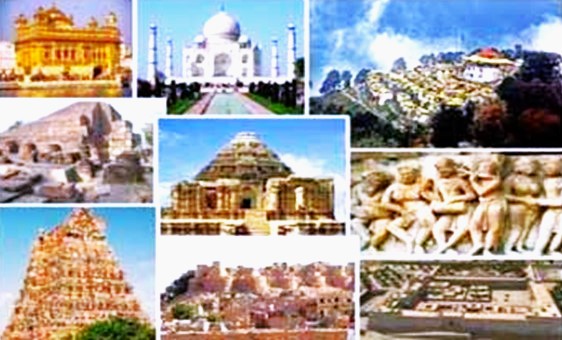
The Seven Wonders of Ancient India. A photo collage of the Multicultural and Multireligious, Architectural Monuments of Ancient India.: Agra, Amritsar, Bihar, Golden Temple, Gomateshwara, Hampi, Kandariya Mahadev, Khajuraho group of temples, Konark, Madhya Pradesh, Modera, Mughal, Nalanda University, Orissa
This publication, Part 1 in series to coincide with the forthcoming General Elections in India, discusses the politico-religious transformation of ancient India from the time of the Indus River Valley Civilisation[2] by the nationalist BJP government, under Prime Minister Narendra Modi, who is in power since 2014 and will win the 2024 general elections.[3] General elections will be held in India from 19 April 2024 to 1 June 2024 to elect the 543 members of the 18th Lok Sabha. The elections will be held in seven phases and the results will be announced on 4 June 2024. This will be the largest-ever election in the history of the mankind, surpassing the 2019 Indian general election, and will last 44 days, second only to the 1951–52 Indian general election. The incumbent prime minister Narendra Modi, who completed a second term, is contesting for a third consecutive term. Approximately 960 million individuals out of a population of 1.4 billion are eligible to participate in the elections.[4] The Legislative assembly elections in the states of Andhra Pradesh, Arunachal Pradesh, Odisha, and Sikkim will be held simultaneously with the general election, along with the by-elections for 35 seats among 16 states.
Hindutva Demystified
Hindutva, pronounced as [hɪnˈdʊtvə], is a political ideology that encompasses the cultural justification of Hindu nationalism and the belief in establishing Hindu hegemony within India12. Definition: The term “Hindutva” combines two words: “Hindu” and the Sanskrit word “tattva” (meaning “thatness” or “essence”). It is popularly translated as “Hindu-ness”. Many Hindus perceive Hindutva as the idea and practice of living life according to Hindu teachings or simply as a descriptor of being Hindu. Origins: Vinayak Damodar Savarkar formulated the political ideology of Hindutva in 1922. It has since been embraced by organizations such as the Rashtriya Swayamsevak Sangh (RSS), the Vishva Hindu Parishad (VHP), and the Bharatiya Janata Party (BJP), collectively known as the Sangh Parivar. Beliefs and Goals: Hindu Nationalism: Hindutva asserts that Indian national identity and culture are inseparable from the religion of Hinduism. Establishing Hindu Hegemony: It advocates for the dominance of Hindu values, traditions, and practices within India. Inspiration from European Fascism: The Hindutva movement draws inspiration from European fascist ideologies, emphasizing a concept of homogenized majority and cultural supremacy. Controversies and Criticism: Right-Wing Extremism: Some describe Hindutva as a variant of right-wing extremism and consider it “almost fascist in the classical sense.” Separatist Ideology: Critics argue that Hindutva promotes a separatist ideology, prioritising Hindu interests over other indigenous religions. In summary, Hindutva represents a complex interplay of cultural identity, nationalism, and political aspirations within the context of Hinduism in India.[5]
Relationship and Analogies between Hindutva and Zionism
Amrit Wilson has published a book[6] on this unholy alliance between Hindutva, the ideology which drives the Hindu-supremacist Bharatiya Janata Party (BJP) regime of Prime Minister Narendra Modi, and Zionism, the ideology of the Israeli apartheid state. In this era of rising fascism, these two remarkably similar ideologies are crucially important in cementing the economic and military alliance between two of the world’s most repressive right-wing states, while helping to legitimize them in cultural arenas. This text was written in 2022, based on a lecture given at the Institute of Palestine Studies. Since then, the relationship between Israel and India has deepened further. Meanwhile, atrocities have skyrocketed in both countries. Israel is facing internal turmoil in a battle between a diverse group, including those who think the current settler colony is a democratic nation and want things to remain as they are, and those who stand even further to the right. Significantly, the BJP, India’s ruling party, supports the latter. Meanwhile, India, too, has seen a horrific escalation of anti-Muslim violence. Not a day passes without Muslims being killed, children beaten up and humiliated, mosques being burnt down or attacked, and homes being destroyed. The book focuses primarily on Hindutva, discussing Zionism mainly to highlight its similarities, links and increasing alliances with Hindutva.
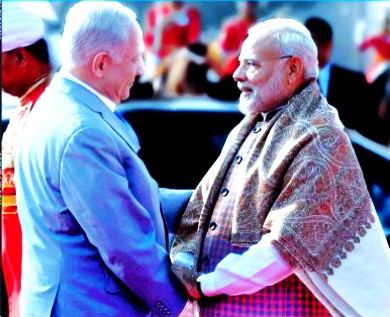
The Unholy alliance between fascist ideologies of Hindutva and Zionism represented by Prime Minister Modi of India and Netanyahu of Israe, respectively.
Photo Credit: Amrit Wilson, Daraia Press.
The year 2024 is shaping up to be an extraordinary election year, with a significant number of countries heading to the polls. A chronological list of nations that are scheduled or expected to hold national elections in 2024 [7]:
- Bangladesh: In January, Bangladesh is set to hold elections, although the main opposition party is boycotting the process due to a crackdown on political dissent.
- Pakistan: In February, Pakistan will have elections, even though former Prime Minister Imran Khan’s party has faced suppression and arrests in the lead-up.
- Russia: In March, Russia will hold its presidential election, where Vladimir Putin is likely to secure another term.
- Ukraine: Although the situation remains uncertain due to martial law, Ukraine is planning a presidential vote in 2024. Incumbent leader Volodymyr Zelensky intends to seek re-election.
- United Kingdom: The U.K. is gearing up for a general election. Opinion polls suggest that the opposition Labour Party may come out on top, potentially ending the Conservative Party’s 14-year rule.
- South Africa: 29th May 2024 has been declared as the official, National and Provincial election day, by President Cyril Ramaphosa, as well as a public holiday to enable eligible citizens to vote democratically, once again, since 1994. The present ANC ruling party’s position is tenuous and a National Government of coalitions between the ANC, EFF and other minor parties is most likely, post-election. The Democratic Alliance will remain as the main opposition, and secure the Province of Western Cape, as always. These elections are particularly significant as they coincide with South Africa’s celebration of 30 years of freedom and democracy. President Ramaphosa encourages all eligible voters to participate fully in this historic milestone of our democratic calendar. He appeals to the citizenry to exercise their democratic right to vote and ensure a peaceful campaign within the bounds of the law. The elections will be monitored by an Independent Electoral Commission.[8]
- United States: In November, the U.S. presidential race will culminate. Former President Donald Trump’s potential bid for a second term looms large.
- Brazil, India, Indonesia, and Mexico: These populous nations will also hold elections in 2024.
All elections can have far-reaching consequences, shaping the course of nations for years to come. Whether it is geopolitical dynamics, economic policies, or democratic processes, these elections matter significantly.
India Demographics[9]
India, officially the Republic of India (ISO: Bhārat Gaṇarājya),[10] is a country in South Asia. It is the seventh-largest country by area; the most populous country as of June 2023;[11] and from the time of its independence in 1947, the world’s most populous democracy.[12]Bounded by the Indian Ocean on the south, the Arabian Sea on the southwest, and the Bay of Bengal on the southeast, it shares land borders with Pakistan to the west; China, Nepal, and Bhutan to the north; and Bangladesh and Myanmar to the east. In the Indian Ocean, India is in the vicinity of Sri Lanka and the Maldives; its Andaman and Nicobar Islands share a maritime border with Thailand, Myanmar, and Indonesia.[13]
India Population (LIVE)[14] is 1,438,625,371 as of Saturday, April 6, 2024, based on Worldometer elaboration of the latest United Nations data. India 2023 population is estimated at 1,428,627,663 people at mid-year. India population is equivalent to 17.76% of the total world population. India ranks number 1 in the list of countries (and dependencies) by population. The population density in India is 481 per Km2 (1,244 people per mi2). The total land area is 2,973,190 Km2 (1,147,955 sq. miles) 36.3 % of the population is urban (518,239,122 people in 2023). The median age in India is 28.2 years.
2024 Indian General Election:
- Election Dates: The general elections in India are scheduled to take place from 19 April 2024 to 1 June 2024. These elections will determine the composition of the 18th Lok Sabha, which consists of 543 members.
- Phases: The elections will be conducted in seven phases, spanning a total of 44 days. The results will be announced on 4 June 2024.
- Significance: This election is poised to be the largest-ever election in the world, surpassing the 2019 Indian general election. It will also be the longest-held general election in India1.
- Incumbent Prime Minister: Narendra Modi, who has completed two terms, will be contesting for a third consecutive term.
- Eligible Voters: Approximately 960 million individuals out of India’s total population of 1.4 billion are eligible to participate in these elections.
The Political Parties of India 2024[15]
India’s political landscape is vibrant and diverse, with several major political parties playing crucial roles. Let’s explore the key national parties:
Indian National Congress (INC):
- Flag: Tricolor (Saffron, White, and Green)
- Election Symbol: Hand (Open Palm)
- Political Position: Center-left
- Ideology: Secularism, Social Democracy
- Founded: 1885
- Leader: Sonia Gandhi
- Seats in Lok Sabha: Varies
- Chief Ministers: INC-led governments in some states
- Alliance Partner: United Progressive Alliance (UPA)
Bharatiya Janata Party (BJP):
- Flag: Saffron
- Election Symbol: Lotus
- Political Position: Right-wing
- Ideology: Hindutva, Nationalism
- Founded: 1980
- Leader: Narendra Modi
- Seats in Lok Sabha: Varies
- Chief Ministers: BJP-led governments in several states
- Alliance Partner: National Democratic Alliance (NDA)
Communist Party of India (Marxist) (CPI-M):
- Flag: Red
- Election Symbol: Hammer and Sickle
- Political Position: Left-wing
- Ideology: Marxism, Secularism
- Founded: 1964
- Leader: Sitaram Yechury
- Seats in Lok Sabha: Varies
- Chief Ministers: Kerala (in coalition)
- Alliance Partner: Left Front
Nationalist Congress Party (NCP):
- Flag: Blue
- Election Symbol: Clock
- Political Position: Center
- Ideology: Secularism, Social Justice
- Founded: 1999
- Leader: Sharad Pawar
- Seats in Lok Sabha: Varies
- Chief Ministers: Maharashtra (in coalition)
- Alliance Partner: United Progressive Alliance (UPA)
Bahujan Samaj Party (BSP):
- Flag: Blue
- Election Symbol: Elephant
- Political Position: Dalit Empowerment
- Ideology: Social Justice, Bahujan Identity
- Founded: 1984
- Leader: Mayawati
- Seats in Lok Sabha: Varies
- Chief Ministers: None (historically held power in Uttar Pradesh)
- Alliance Partner: Varies
All India Trinamool Congress (AITC):
- Flag: Tricolor (Blue, White, and Green)
- Election Symbol: Flowers and Grass
- Political Position: Center-left
- Ideology: Regionalism, Secularism
- Founded: 1998
- Leader: Mamata Banerjee
- Seats in Lok Sabha: Varies
- Chief Ministers: West Bengal
- Alliance Partner: None (formerly part of UPA)
These parties represent diverse ideologies, regional interests, and historical legacies. India’s democratic fabric thrives on the competition and cooperation among these political entities.
The 2024 elections across various countries are poised to address critical issues that resonate with citizens. Let’s explore some of these key themes:
Economy:
- The state of the economy remains a central concern. While the post-Covid recovery seems on track, cost-of-living worries persist, and inflation remains high. Voters will assess whether the economy is strong and working for them personally.
Equality:
- Attacks on LGBTQ+ rights and efforts to demonize so-called “woke” ideology are contentious issues. Tangible results include anti-trans legislation, book bans, and restrictions on LGBTQ+ education. Traditional race-inflected battles also play a role, with immigration and crime remaining focal points.
Abortion Rights:
- The party divide over abortion rights is stark. The Dobbs v Jackson Supreme Court ruling striking down Roe v Wade, draconian bans in Republican states, and candidates’ positions on abortion will be fiercely debated.
Social Security and Medicare:
- Protecting and strengthening social safety nets like Social Security and Medicare will be a critical issue. Candidates’ stances on these programs will shape voters’ decisions2.
Climate Crisis:
- Climate change remains a global challenge. Voters will scrutinize candidates’ plans for environmental protection, clean energy, and climate resilience1.
National Security and Terrorism:
- Concerns about terrorism and national security persist. Voters will assess candidates’ approaches to safeguarding the nation and addressing global threats3.
Immigration:
- Immigration policies and border security continue to be contentious. Voters will consider candidates’ positions on immigration reform and border control3.
Race Relations:
- Struggles related to race and ethnicity remain relevant. Debates over affirmative action, criminal justice reform, and racial equity will shape the campaign trail1.
Healthcare:
- Access to quality healthcare and the future of healthcare systems will be discussed. Voters will evaluate candidates’ proposals for healthcare reform4.
Democracy and Civic Participation:
- The fate of democracy itself is at stake. Issues related to voting rights, electoral integrity, and democratic institutions will be pivotal.
Remember that these issues vary by country, and each election context brings its unique challenges and priorities.
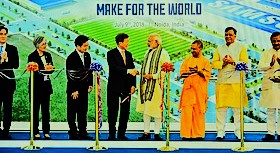
The Prime Minister, Shri Narendra Modi and the President of the Republic of Korea, Mr. Moon Jae-in jointly inaugurating the Samsung manufacturing plant, World’s Largest Mobile Factory, in Noida, Uttar Pradesh on July 09, 2018…The Chief Minister of Uttar Pradesh, Yogi Adityanath, the Minister of State for Culture (I/C) and Environment, Forest & Climate Change, Dr. Mahesh Sharma and other dignitaries are also seen..
Mechanisms used by Modi to stir up nationalistic Hindu fervour to become a major political party, having ousted the Congress Party of Gandhi.
Narendra Modi, the current Prime Minister of India, has indeed played a significant role in shaping the political landscape by leveraging nationalistic Hindu fervour. It is prudent explore how he and his party, the Bharatiya Janata Party (BJP), have achieved this:
- Hindutva Narrative:
- Modi and the BJP have embraced the ideology of Hindutva, which seeks to promote Hindu identity and culture as central to Indian nationalism.
- They emphasize India’s historical Hindu heritage and position it as the foundation of the nation.
- Ayodhya Ram Temple:
- One of the most symbolic moves was the Ayodhya Ram temple construction.
- The BJP successfully navigated the legal and political complexities to build a grand temple at the disputed site in Ayodhya, where the Babri Masjid once stood.
- This move resonated deeply with Hindu sentiments and solidified the BJP’s position as the champion of Hindu causes.
- Cow Protection and Beef Politics:
- The BJP has actively promoted cow protection and advocated for stricter laws against cow slaughter.
- Cow veneration is deeply ingrained in Hindu culture, and the party’s stance on this issue appeals to conservative Hindus.
- Nationalism and Security:
- Modi’s government has emphasized national security and a strong stance against terrorism.
- The Balakot airstrikes in response to the Pulwama attack and the surgical strikes have been used to project a tough image.
- Cultural Nationalism:
- The BJP promotes cultural nationalism, emphasizing Indian traditions, festivals, and symbols.
- Events like the Statue of Unity (dedicated to Sardar Patel) and the National War Memorial reinforce this narrative.
- Electoral Strategy:
- The BJP has strategically targeted Hindu-majority states and regions.
- Their electoral campaigns often invoke Hindu symbols, rituals, and historical figures.
- Marginalisation of Opposition:
- The BJP has effectively marginalized the Indian National Congress (INC), the party of Mahatma Gandhi and Jawaharlal Nehru.
- The INC’s secular stance has been challenged by the BJP’s assertive Hindu identity politics.
- Social Media and Propaganda:
- Modi’s team has effectively used social media and digital platforms to disseminate their message.
- The BJP’s IT cell and online supporters amplify the party’s narrative.
In summary, Modi’s leadership and the BJP’s strategic use of Hindu nationalism have propelled them to prominence, outshining the once-dominant Congress Party. The political landscape in India continues to evolve, shaped by these dynamics.
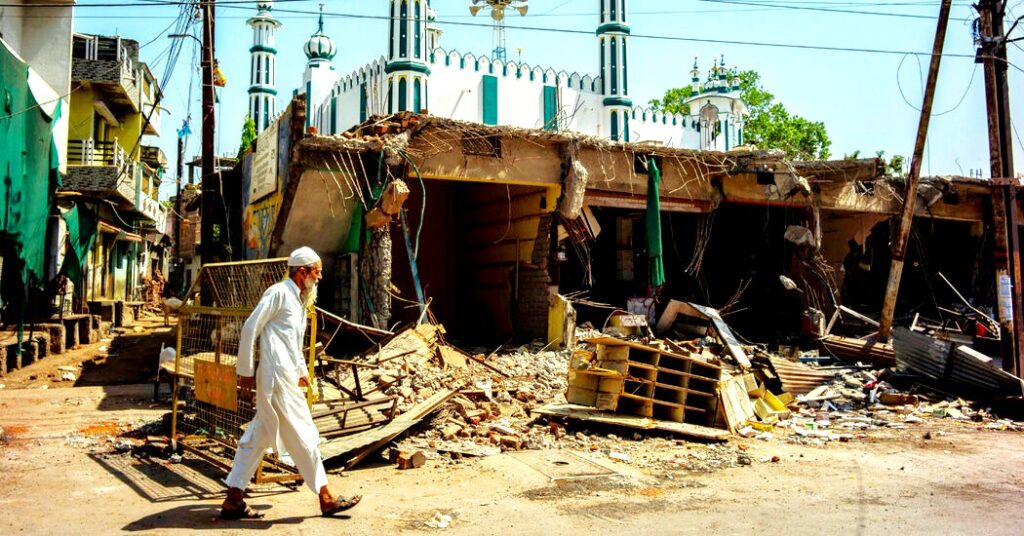
Perpetual Violence’: India’s Dangerous New Pattern of Communal Tensions Religious, Intercommunal Violence in Khrgone, India. The authorities sent bulldozers to the small city in central India within 24 hours of clashes between Hindus and Muslims that turned into a mob-fuelled rampage, in which mosques where demolished and Muslims as well as Hindus were injured and killed. As a national campaign by right-wing Hindutva groups inflames local tensions, Muslim communities are facing the harshest punishments, according to activists, analysts and retired officials.
Photo Credit: Hari Kumar, Mujib Mashal and Suhasini Raj / NY Times
The Bottom-Line Transformation from India to Bharat, a dangerous, explosive cocktail of Politics and Religious Discrimination: The unfinished neo-Partition of India of 1947.[16], [17]
The Bottom Line is that India derives its name, as a country, from the Indu River Valley Civilization of antiquity. ‘Shrusti Devo Shilpam, TTasya Pratikruti Manushya Shilpam’, it means ‘Nature is the art of god and human art is just a gist and imagination of it’. Therefore, the art developed by the men is influenced and copied from the nature. Indian art and architecture has beautiful and magnificent examples of this brilliant influence. These monuments are the insignia of Indian culture and tradition. There are so many of such splendid structures on this land, yet the best chosen among them are renowned monuments known all over the world as the “seven wonders of India”. These massive architectural miracles have ornamented this land with its splendid beauty.[18] Against such a ancient backdrop, the BJP has brought about a religious transformation under the pretext of propagating peace, but is is actually a long term strategy of Pseudo-Peace and the ultimate aim is to create a nationalist India using the religious card of Hinduism to gain votes amongst its 1.42 billion diverse population. Essentially the BJP has embarked on a cultural and religious genocide to create a new country; “Bharat” which is exclusively for Hindus, as enunciated by the statement of Adityanath Yogi: “The country will never vote in favour of those who do not acknowledge Lord Ram and Lord Krishna”[19] Yogi Adityanath, the Chief Minister of Uttar Pradesh, is a prominent figure in Indian politics, known for his association with the Bharatiya Janata Party (BJP). His journey from being a monk to a political leader has been marked by strong ideological beliefs and a focus on development of Hindutva.[20] He is the most loyal colleague of Prime Minister Modi. Yogi Adityanath, born as Ajay Singh Bisht, is an Indian politician and a prominent leader associated with the Bharatiya Janata Party (BJP). He currently serves as the Chief Minister of Uttar Pradesh, the most populous state in India. Early Life and Spiritual Journey: Yogi Adityanath was born on June 5, 1972, in Panchur village, Uttarakhand, India. He was initiated into the Nath tradition of Hindu monasticism at a young age and became a sannyasi (ascetic) with the name Yogi Adityanath. His spiritual journey led him to the Gorakhnath Math, a prominent Hindu monastery in Gorakhpur, Uttar Pradesh. Political Career: Yogi Adityanath entered politics and became a member of the Lok Sabha (Indian Parliament) in 1998. He has been elected as a Member of Parliament (MP) from the Gorakhpur constituency multiple times. Known for his strong Hindutva ideology, he has been an advocate for the rights and interests of Hindus. Chief Minister of Uttar Pradesh: In March 2017, Yogi Adityanath was appointed as the Chief Minister of Uttar Pradesh after the BJP secured a majority in the state assembly elections. His tenure has been marked by various developmental initiatives, including infrastructure projects, education reforms, and healthcare improvements. Controversies and Criticisms: Yogi Adityanath has faced criticism for his statements related to religious and communal matters. His administration has been accused of being involved in incidents of communal violence. However, his supporters view him as a strong leader who prioritizes the welfare of the state. Hindutva and Nationalism: Yogi Adityanath strongly identifies with the Hindutva ideology, which emphasizes the cultural and religious identity of Hindus. He is highly popular amongst the Hindu majority and was a clever strategic move by Modi to appoint him into parliament, bringing with the large Hindu following, as voters for BJP. He is the most like successor of Modi in the future.[21] It is interesting to note that for India’s Independence Day celebrations in 2017, his government singled out Muslim religious schools, requiring them to provide video evidence that their students had sung the Indian national anthem.[22],[23].
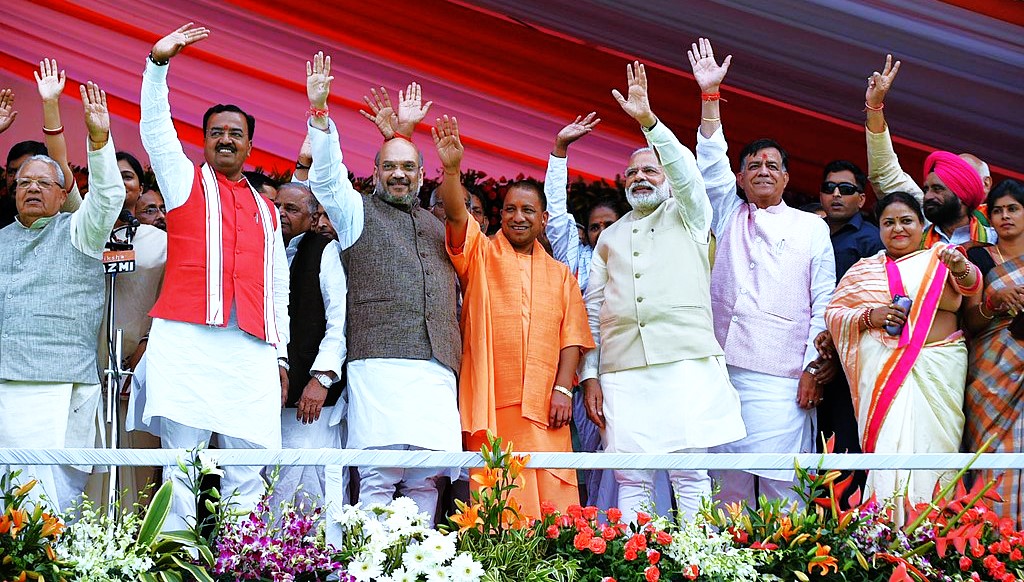
Prime Minister Narendra Modi and other Bharatiya Janata Party leaders at the swearing in ceremony of Yogi Adityanath attired in his traditional saffron Coloured, Yogi Attire, bringing about the “Hindutva, Saffrom Revolution”, quietly, under the pretext of “Peace Propagation” in the Hindu majority India, with marginalization and persecution of minority groups mainly based on religion. Photo Credit: wikimedia.org/wikipedia/commons
References:
[1] Personal quote by author, April 2024
[2] https://www.khanacademy.org/humanities/world-history/world-history-beginnings/ancient-india/a/the-indus-river-valley-civilizations#:~:text=The%20Indus%20Valley%20Civilization%20is,during%20the%20Mature%20Harappan%20Phase.
[3] https://en.wikipedia.org/wiki/2024_Indian_general_election
[4] https://en.wikipedia.org/wiki/2024_Indian_general_election
[5] https://www.bing.com/ck/a?!&&p=599c2574caa2f81fJmltdHM9MTcxMjM2MTYwMCZpZ3VpZD0wOWJkOGFlOC0zZmI2LTZjZWYtMmI5MS05ZWExM2UyODZkM2MmaW5zaWQ9NTUxMw&ptn=3&ver=2&hsh=3&fclid=09bd8ae8-3fb6-6cef-2b91-9ea13e286d3c&psq=What+is+Hindutva&u=a1aHR0cHM6Ly9lbi53aWtpcGVkaWEub3JnL3dpa2kvSGluZHV0dmEjOn46dGV4dD1IaW5kdXR2YSUyMCUyOEhpbmRpJTIwcHJvbnVuY2lhdGlvbiUzQSUyMCU1QmglQzklQUFuJUNCJTg4ZCVDQSU4QXR2JUM5JTk5JTVEJTIwbGl0LiUyMCUyN0hpbmR1LW5lc3MlMjclMjklMjBpcyUyMGEsd2FzJTIwZm9ybXVsYXRlZCUyMGJ5JTIwVmluYXlhayUyMERhbW9kYXIlMjBTYXZhcmthciUyMGluJTIwMTkyMi4&ntb=1
[6] https://zandpress.com/catalog/hindutva-and-its-relationship-with-zionism/
[7] https://time.com/6550920/world-elections-2024/
[8] https://www.elections.org.za/content/About-Us/News/Electoral-Commission-partners-with-social-media-giants-to-combat-disinformation-in-2024-National-and-Provincial-Elections/
[9] https://www.bing.com/ck/a?!&&p=fd0be5b2d9db0ecbJmltdHM9MTcxMjM2MTYwMCZpZ3VpZD0wOWJkOGFlOC0zZmI2LTZjZWYtMmI5MS05ZWExM2UyODZkM2MmaW5zaWQ9NTE5OQ&ptn=3&ver=2&hsh=3&fclid=09bd8ae8-3fb6-6cef-2b91-9ea13e286d3c&psq=What+is+the+population+of+India+today&u=a1aHR0cHM6Ly93d3cud29ybGRvbWV0ZXJzLmluZm8vd29ybGQtcG9wdWxhdGlvbi9pbmRpYS1wb3B1bGF0aW9uLw&ntb=1
[10] https://books.google.com/books?id=yjcOAQAAMAAJ&pg=PA76
[11] https://www.bbc.com/news/world-asia-india-65322706
[12] https://en.wikipedia.org/wiki/India#CITEREFFisher2018
[13] https://en.wikipedia.org/wiki/India
[14] https://www.worldometers.info/world-population/india-population/#google_vignette
[15] https://timesofindia.indiatimes.com/elections/lok-sabha-elections/parties/list-of-parties-contesting-lok-sabha-elections-2024/articleshow/102199909.cms
[16] https://en.wikipedia.org/wiki/Partition_of_India
[17] https://www.newyorker.com/magazine/2015/06/29/the-great-divide-books-dalrymple
[18] https://www.mintageworld.com/blog/seven-wonders-india/
[19] https://www.bing.com/ck/a?!&&p=252a565518c77a22JmltdHM9MTcxMjM2MTYwMCZpZ3VpZD0wOWJkOGFlOC0zZmI2LTZjZWYtMmI5MS05ZWExM2UyODZkM2MmaW5zaWQ9NTE4OA&ptn=3&ver=2&hsh=3&fclid=09bd8ae8-3fb6-6cef-2b91-9ea13e286d3c&psq=The+country+will+never+vote+in+favour+of+those+who+do+not+acknowledge+Lord+Ram+and+Lord+Krishna&u=a1aHR0cHM6Ly93d3cuYnJhaW55cXVvdGUuY29tL3F1b3Rlcy95b2dpX2FkaXR5YW5hdGhfMTAwNDE0MQ&ntb=1
[20] https://www.asianstudies.org/publications/eaa/archives/on-the-difference-between-hinduism-and-hindutva/
[21] https://en.wikipedia.org/wiki/Yogi_Adityanath
[22] https://en.wikipedia.org/wiki/Jana_Gana_Mana
[23] http://indiatoday.intoday.in/story/yogi-adityanath-big-decisions-uttar-pradesh-slaughter-houses/1/910001.html
______________________________________________
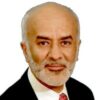 Professor G. Hoosen M. Vawda (Bsc; MBChB; PhD.Wits) is a member of the TRANSCEND Network for Peace Development Environment.
Professor G. Hoosen M. Vawda (Bsc; MBChB; PhD.Wits) is a member of the TRANSCEND Network for Peace Development Environment.
Director: Glastonbury Medical Research Centre; Community Health and Indigent Programme Services; Body Donor Foundation SA.
Principal Investigator: Multinational Clinical Trials
Consultant: Medical and General Research Ethics; Internal Medicine and Clinical Psychiatry:UKZN, Nelson R. Mandela School of Medicine
Executive Member: Inter Religious Council KZN SA
Public Liaison: Medical Misadventures
Activism: Justice for All
Email: vawda@ukzn.ac.za
Tags: Elections, Hindus, India, Krishna, Lord Rama, Mahabharata, Muslims, Narendra Modi, Politics
This article originally appeared on Transcend Media Service (TMS) on 8 Apr 2024.
Anticopyright: Editorials and articles originated on TMS may be freely reprinted, disseminated, translated and used as background material, provided an acknowledgement and link to the source, TMS: Bharatiya Janata Party: Pseudo Peace Propagation in Narendrabhai Damodardas Modi’s Bharat Hindutva (Part 1), is included. Thank you.
If you enjoyed this article, please donate to TMS to join the growing list of TMS Supporters.

This work is licensed under a CC BY-NC 4.0 License.